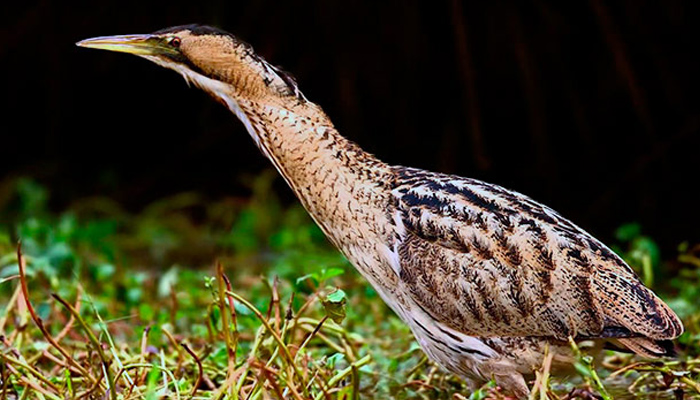 English: Great Bittern, Common Bittern, Eurasian Bittern
English: Great Bittern, Common Bittern, Eurasian Bittern
Russian: Большая выпь
German: Rohrdommel
French: Butor
etoile
Mongolian: Усны бухшувуу
Japanese:サンカノゴイ(Sankano-goi)
Body length: 69-81 cm
Wing span: 100-130 cm
Passage migrant
Breeding season: May-August
Egg number: 4-6 (occasionally
3-7)
Egg color: Non-glossy olive
brown with darker brown fine sprinkles.
Brood: 1 per year
Food: Fishes, amphibians and
aquatic insects.
Status: Rare species. According to the IUCN Red List categories and
criteria, the species evaluated as-Near Threatened.
Distribution and range In Mongolia: Breeds in
most large and small lakes, i.e, Orog Boontsagaan, Dorgon, Khar, Khar Us,
Airag, Uvs, Khovsgol, Buir, Tashgain Tavan Nuur Lakes and Zavkhan, Khovd,
Orkhon, Selenge, Tuul, Kherlen, Onon, Ulz, Khalkh, Nomrog, Degee, and Azarga
Rivers basins.
Habitat: Breeds
only in extensive Phragmites reedbeds. Retreats from ice, but is hardy, returns
early. Food mainly fish, frogs, insects. Polygamous. Nest a platform of dead
reeds at water-level in reedbed. Distribution range stretches from the Western Europe in the west
to Sakhalin and Japanese islands in the east, from Tundra zone in the north to
Southern tip of Africa. Wintering area are Mediterranean Sea, Eastern and
Central Africa, India, Myanmar, and Southeastern China.
Identification:
Large buff-brown heron; slightly smaller than Grey Heron, but shape much more
compact and stocky, with thicker neck (usually hunched into shoulders), loose
throat feathering, and shorter legs. Flies rather infrequently, mainly in
spring and early autumn. In flight, note broad wings, quicker wingbeats than
Grey Heron, ‘thick’ front end and trailing feet; at distance looks all
ginger-brown (broad wings and brown colour recalling buzzard or owl) with only
slightly paler wing-coverts than darker flight-feathers. Rarely seen on ground
(stays hidden in reedbed), and presence mostly revealed by distinctive voice;
when alarmed in reedbed, adopts camouflage posture with bill pointing up. Juvenile:
like adult, but crown and shorter moustachial stripe browner.
Population and Threats: Degradation of habitat due to long lasted drought, overgrazing of
pasture along the lake shores, disturbance, of nesting sites and dry out of
lakes.
Conservation Measures: Included as Rare animal in the Annex to the Mongolian Government
Resolution #7 (2012). Some parts of distribution area is included within the
NSPAN.
Further Actions: Restrict disruptions at breeding sites, establish lakes and
rivers protected zones, forbid, livestock grazing; include in the appropriate
international convention appendix, annexes, improve the conservation management
In the NSPAN, assess population abundance.